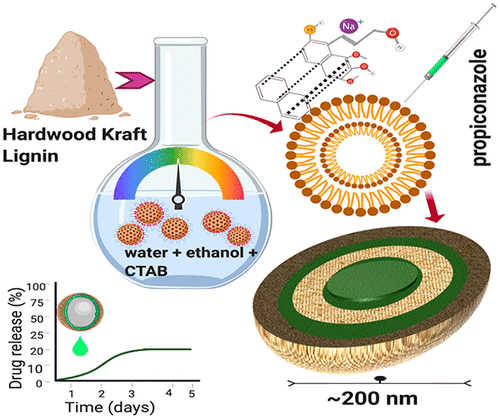当前位置:
X-MOL 学术
›
ACS Sustain. Chem. Eng.
›
论文详情
Our official English website, www.x-mol.net, welcomes your
feedback! (Note: you will need to create a separate account there.)
Double-Shell Lignin Nanocapsules Are a Stable Vehicle for Fungicide Encapsulation and Release
ACS Sustainable Chemistry & Engineering ( IF 7.1 ) Pub Date : 2020-11-12 , DOI: 10.1021/acssuschemeng.0c06686 Raisa Carmen Andeme Ela 1 , Momoko Tajiri 2 , Nick K. Newberry 2 , Patricia A. Heiden 2 , Rebecca G. Ong 1
ACS Sustainable Chemistry & Engineering ( IF 7.1 ) Pub Date : 2020-11-12 , DOI: 10.1021/acssuschemeng.0c06686 Raisa Carmen Andeme Ela 1 , Momoko Tajiri 2 , Nick K. Newberry 2 , Patricia A. Heiden 2 , Rebecca G. Ong 1
Affiliation

|
Industry is increasingly turning to biobased and environmentally benign materials for use in high-value applications. Kraft lignin’s low cost and inherent properties, such as its easily tunable amphiphilic nature, adsorption capacity, and natural cross-linking tendency, make it suitable for use as a raw material for high-value nanomaterials. To support that need, this paper describes the synthesis of innovative, double-shelled lignin nanocapsules from hardwood kraft lignin, their performance towards encapsulating a fungicide, and effectiveness at controlling its release. The recovered lignin was dissolved without further modification in tetrahydrofuran and inserted dropwise into a water/ethanol solution containing sacrificial surfactant templates. Monodispersed, hollow, double-shell nanocapsules were produced via a two-step self-assembly. The water/ethanol solution acted as a nonsolvent while simultaneously providing strategic sites for controlled-size production. The shells of the nanocapsules were cross-linked with biodegradable maleic anhydride to bolster the structural stability. The average hydrodynamic diameter of the particles was 241.8 ± 33.3 nm, and these structures were stable in water for a period of eight months. The specific surface area of kraft lignin increased by 4-fold in the double-shell nanocapsule form. The nanocapsules were loaded with propiconazole at an entrapment efficiency of 56.1%. This system could represent an effective method to enable biologically activated, controlled release of fungicides.
中文翻译:

双壳木质素纳米胶囊是用于杀菌剂封装和释放的稳定载体
工业界越来越多地将生物基和环保材料用于高价值应用。硫酸盐木质素的低成本和固有特性,例如其易于调节的两亲性质,吸附能力和自然的交联趋势,使其适合用作高价值纳米材料的原料。为了满足这一需求,本文描述了由硬木牛皮纸木质素合成创新的双壳木质素纳米胶囊,其对杀菌剂的封装性能以及控制其释放的有效性。将回收的木质素不经进一步修饰就溶解在四氢呋喃中,并逐滴插入含有牺牲性表面活性剂模板的水/乙醇溶液中。通过两步自组装生产单分散的中空双壳纳米胶囊。水/乙醇溶液充当非溶剂,同时为控制规模的生产提供了战略要地。纳米胶囊的壳与可生物降解的马来酸酐交联以增强结构稳定性。颗粒的平均流体动力学直径为241.8±33.3 nm,这些结构在水中稳定八个月。牛皮纸木质素的比表面积在双壳纳米胶囊形式中增加了4倍。纳米胶囊载有丙环唑,包封率为56.1%。该系统可以代表一种有效的方法,能够实现生物激活,控制释放的杀菌剂。纳米胶囊的壳与可生物降解的马来酸酐交联以增强结构稳定性。颗粒的平均流体动力学直径为241.8±33.3 nm,这些结构在水中稳定八个月。牛皮纸木质素的比表面积在双壳纳米胶囊形式中增加了4倍。纳米胶囊载有丙环唑,包封率为56.1%。该系统可以代表一种有效的方法,能够实现生物激活,控制释放的杀菌剂。纳米胶囊的壳与可生物降解的马来酸酐交联以增强结构稳定性。颗粒的平均流体动力学直径为241.8±33.3 nm,这些结构在水中稳定八个月。牛皮纸木质素的比表面积在双壳纳米胶囊形式中增加了4倍。纳米胶囊载有丙环唑,包封率为56.1%。该系统可以代表一种有效的方法,能够实现生物激活,控制释放的杀菌剂。牛皮纸木质素的比表面积在双壳纳米胶囊形式中增加了4倍。纳米胶囊载有丙环唑,包封率为56.1%。该系统可以代表一种有效的方法,能够实现生物激活,控制释放的杀菌剂。牛皮纸木质素的比表面积在双壳纳米胶囊形式中增加了4倍。纳米胶囊载有丙环唑,包封率为56.1%。该系统可以代表一种有效的方法,能够实现生物激活,控制释放的杀菌剂。
更新日期:2020-11-23
中文翻译:

双壳木质素纳米胶囊是用于杀菌剂封装和释放的稳定载体
工业界越来越多地将生物基和环保材料用于高价值应用。硫酸盐木质素的低成本和固有特性,例如其易于调节的两亲性质,吸附能力和自然的交联趋势,使其适合用作高价值纳米材料的原料。为了满足这一需求,本文描述了由硬木牛皮纸木质素合成创新的双壳木质素纳米胶囊,其对杀菌剂的封装性能以及控制其释放的有效性。将回收的木质素不经进一步修饰就溶解在四氢呋喃中,并逐滴插入含有牺牲性表面活性剂模板的水/乙醇溶液中。通过两步自组装生产单分散的中空双壳纳米胶囊。水/乙醇溶液充当非溶剂,同时为控制规模的生产提供了战略要地。纳米胶囊的壳与可生物降解的马来酸酐交联以增强结构稳定性。颗粒的平均流体动力学直径为241.8±33.3 nm,这些结构在水中稳定八个月。牛皮纸木质素的比表面积在双壳纳米胶囊形式中增加了4倍。纳米胶囊载有丙环唑,包封率为56.1%。该系统可以代表一种有效的方法,能够实现生物激活,控制释放的杀菌剂。纳米胶囊的壳与可生物降解的马来酸酐交联以增强结构稳定性。颗粒的平均流体动力学直径为241.8±33.3 nm,这些结构在水中稳定八个月。牛皮纸木质素的比表面积在双壳纳米胶囊形式中增加了4倍。纳米胶囊载有丙环唑,包封率为56.1%。该系统可以代表一种有效的方法,能够实现生物激活,控制释放的杀菌剂。纳米胶囊的壳与可生物降解的马来酸酐交联以增强结构稳定性。颗粒的平均流体动力学直径为241.8±33.3 nm,这些结构在水中稳定八个月。牛皮纸木质素的比表面积在双壳纳米胶囊形式中增加了4倍。纳米胶囊载有丙环唑,包封率为56.1%。该系统可以代表一种有效的方法,能够实现生物激活,控制释放的杀菌剂。牛皮纸木质素的比表面积在双壳纳米胶囊形式中增加了4倍。纳米胶囊载有丙环唑,包封率为56.1%。该系统可以代表一种有效的方法,能够实现生物激活,控制释放的杀菌剂。牛皮纸木质素的比表面积在双壳纳米胶囊形式中增加了4倍。纳米胶囊载有丙环唑,包封率为56.1%。该系统可以代表一种有效的方法,能够实现生物激活,控制释放的杀菌剂。









































 京公网安备 11010802027423号
京公网安备 11010802027423号